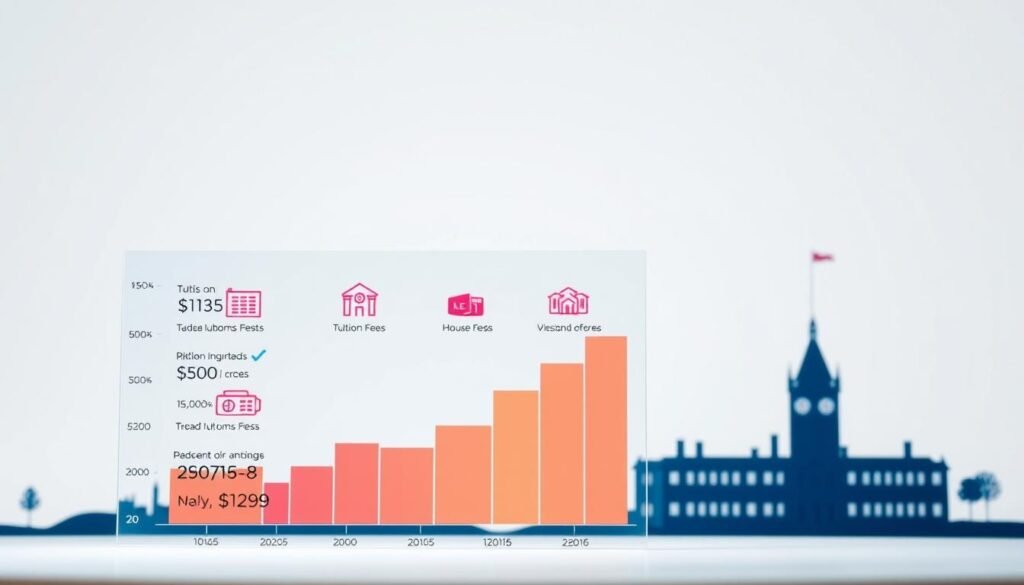
Your Guide to Private Student Loans for MBA USA Programs

Curious which lender will save you the most over two years of business school? This guide gives a clear, practical start so you can compare offers and avoid surprises.
You will see how top names like Sallie Mae and Ascent structure rates, grace periods, and repayment choices. Some lenders list fixed APRs as low as 3.45% and variable as low as 4.37%. Others offer long in‑school deferments and interest‑only options.
Start by mapping your cost attendance: tuition, fees, housing, and tech. Then layer in scholarships, employer aid, and federal aid before you borrow.
By the end of this article you’ll know how to estimate total cost, check prequalification without a credit hit, and match repayment options to your cash flow.
For deeper comparisons and borrowing tips, visit our lender overview.
- How to choose the right MBA loan for your needs and budget
- Private student loans for MBA USA: where to start your comparison
- Top lenders at a glance: rates, loan terms, and borrower fit
- Deep dive: Sallie Mae MBA Loan benefits and repayment options
- Deep dive: Ascent MBA student loan features for flexibility
- Comparing rates and discounts today
- Eligibility snapshots: enrolled at least half‑time, cosigner rules, and residency
- Private vs. federal loans for MBA: which route fits you
- Application timeline and steps to funding your business school
- Your next steps to secure financing with confidence
How to choose the right MBA loan for your needs and budget
Before you borrow, nail down the real cost your program will charge and what you’ll need to cover. That certified figure anchors what lenders can approve and prevents unnecessary borrowing.
Define your cost of attendance and how much to borrow
Request the official cost attendance from your school. Include tuition, fees, housing, meals, travel, and required tech so the lender can certify a correct loan amount.

Match repayment options to your cash flow in school and after
Compare interest-only, $25 minimum, immediate principal interest, and deferred repayment. Project monthly payments during school and after graduation to see which repayment option fits your budget.
- Model lifetime interest at possible interest rate scenarios and different loan terms.
- Shorter loan term lowers total cost but raises monthly payments; choose the shortest you can afford.
- Remember deferred repayment preserves cash now but increases loan payments later through capitalization of unpaid interest.
- Check eligibility rules U.S. citizens, u.s. permanent residents, or a qualified cosigner affect access and pricing; verify lender minimums and maximums (Ascent cap up to $400,000; Sallie Mae terms 5–15 years).
Private student loans for MBA USA: where to start your comparison
Compare lender quotes early so you can spot how underwriting affects your price. That helps you see which choices lower lifetime cost and which create surprise bills later.

What “subject to credit approval” really means
Loans subject to credit approval means lenders review your credit history, income, program, and sometimes a cosigner to set terms. This verification determines whether you get the lowest offers or a higher rate.
Tip: Use lenders that offer a soft prequalification so you can compare without a hard pull. Ascent, SoFi, and College Ave let you see estimates first.
Fixed APR vs. variable rates how payments may vary
Fixed APR locks your interest cost. That predictability makes budgeting easier.
By contrast, variable rates track benchmarks (for example, SOFR) and may increase over time. That means your monthly payment may vary and could rise if market rates climb.
- Lowest rates often require top credit, a cosigner, shortest term, and immediate repayment.
- Choosing deferment or longer terms typically raises pricing.
- Confirm grace period lengths (commonly 6 or 9 months) so you know when full payments start.
- Many lenders require you be enrolled least half-time; some accept part-time enrollment.
| Factor | How it affects price | Typical lender stance | Action you can take |
|---|---|---|---|
| Credit history | Lower risk = lower rate | Top rates need strong credit or cosigner | Prequalify with soft check; add cosigner if needed |
| Repayment option | Immediate repayment lowers rate | Deferred or interest-only can cost more | Model payments for each option |
| Rate type | Fixed = stable; variable = may increase | Variable tied to benchmarks and reset rules | Read reset frequency and caps before signing |
| Enrollment status | Full or half-time affects eligibility | Some lenders allow part-time enrollment | Confirm school certification rules early |
Top lenders at a glance: rates, loan terms, and borrower fit
Survey leading providers to compare rates, grace periods, and borrower perks at a glance.
Sallie Mae offers fixed APRs from 3.45%–14.99% and variable rates from 4.37%–13.98%. You get a 6‑month grace period, an auto‑debit discount (0.25%), and the option to make up to 12 interest‑only payments after grace if you qualify.

Ascent stands out for repayment flexibility: immediate P&I, interest‑only, $25 minimum, or deferred. It has a 9‑month grace and an aggregate cap to $400,000. Note that variable rates may rise after consummation.
Simpler choices for part‑time or creditworthy applicants
College Ave is part‑time friendly with fixed 2.89%–14.49% and variable 4.24%–14.49%. It offers multiple terms and a 9‑month grace.
SoFi and Earnest favor excellent profiles. SoFi lists fixed 3.43%–14.83% and variable 4.64%–15.86%. Earnest shows fixed 4.45%–14.30% and variable 4.99%–15.15%, plus a perk to skip one payment each 12 months.
| Lender | Fixed APR / Variable | Grace & perks | Who fits |
|---|---|---|---|
| Sallie Mae | 3.45%–14.99% / 4.37%–13.98% | 6‑month grace; 0.25% autopay; 12 months interest‑only (qualify) | Wide coverage; up to 100% certified COA |
| Ascent | Range varies; variable may change | 9‑month grace; up to 36‑month in‑school deferment; autopay discount | Flexible repayment; high aggregate cap |
| College Ave | 2.89%–14.49% / 4.24%–14.49% | 9‑month grace; multiple terms | Part‑time enrollment friendly |
| SoFi / Earnest | SoFi: 3.43%–14.83% / 4.64%–15.86% Earnest: 4.45%–14.30% / 4.99%–15.15% | 9‑month grace; digital tools; skip‑payment perk (Earnest) | Creditworthy applicants seeking longer terms |
"Information advertised often assumes autopay and top credit. Verify your personalized quote before you commit."
Quick tip: Build a shortlist with two fixed apr quotes and one variable quote, then model total cost across likely loan terms. For broader rankings, check this best private lender guide.
Deep dive: Sallie Mae MBA Loan benefits and repayment options
Before you commit, review how Sallie Mae structures coverage and in‑school payment choices. This helps you match a loan amount and repayment plan to your career timeline and cash flow.
Coverage and core terms
You can borrow up to 100% of your certified cost attendance with no origination or prepayment fees. Terms range from 5 to 15 years, and advertised fixed APRs run 3.45%–14.99% while variable rates are 4.37%–13.98% (tied to 30‑day average SOFR).
In‑school period and grace details
During the in‑school period you may choose interest‑only, pay a fixed $25, or defer repayment. After school, there is a six‑month grace period.
Qualifying borrowers may then elect up to 12 months of interest‑only payments to ease the jump to full payments.
Eligibility and cosigner rules
Applications are loans subject to credit approval, identity checks, signed documents, and certified school paperwork. International and DACA applicants: a cosigner must be a U.S. citizen or u.s. permanent resident.
Tip: Plan ahead if you aim to pursue cosigner release; you typically need at least 12 on‑time P&I payments plus qualifying credit and income.
| Feature | What it means | Typical terms | Action for you |
|---|---|---|---|
| Coverage | Up to certified COA | 100% of cost attendance | Certify full cost early |
| Repayment options | In‑school flexibility | Interest‑only / $25 / Deferred | Model costs for each choice |
| Grace & post‑school | Transition time | 6‑month grace; 12 mo interest‑only | Use interest‑only to smooth payments |
| Eligibility | Approval and cosigner rules | Credit check; cosigner must qualify | Prequalify with soft check; confirm cosigner status |
Deep dive: Ascent MBA student loan features for flexibility
Ascent gives four in‑school repayment paths so you can control cost while you study.
Repayment options that match your cash flow
Immediate full principal and interest lowers total interest and speeds payoff.
Interest‑only keeps payments moderate while limiting added principal. A $25 minimum keeps your account current. Deferred repayment pauses payments while you focus on classes.
Deferment, grace, and discounts
You can defer up to 36 months when enrolled least half-time, then use a 9‑month school grace to prepare for full billing.
Automating payments earns an autopay discount. Discount levels change by application date (0.25% earlier; 0.5% on or after 6/1/2025). Note that variable rates may increase after consummation, so weigh predictability versus risk.
Eligibility and loan planning
- Confirm your loan amount fits within Ascent’s $400,000 aggregate cap and the minimums ($2,001; $6,001 in MA).
- If you’re international, a cosigner must be a U.S. citizen or permanent resident; DACA applicants may qualify without one.
Tip: Run amortization comparisons to see how choosing full principal versus deferred repayment affects lifetime cost.
Comparing rates and discounts today
Shop rates like a pro: collect same‑day quotes so you can spot meaningful pricing differences and choose the best path for your budget.
What affects your interest rate: credit history, cosigner, and repayment option
Your quoted interest rates reflect your credit history, whether you add a cosigner, the repayment option you select, and the loan term length.
Lower pricing usually comes with immediate full principal and interest, a short term, and very strong credit or a qualifying cosigner. Choosing deferred or interest‑only repayment tends to raise your APR and total interest.
Auto‑debit discounts: 0.25% to 1.00% and how “information advertised” can change
Activate auto‑debit to earn advertised reductions. Sallie Mae applies a 0.25% discount during active repayment. Ascent has offered 0.25%–0.50% on recent credit‑based loans depending on submission date.
Note: lender disclosures show that advertised ranges and discounts can update. Variable APRs tied to benchmarks like SOFR may vary and could increase after consummation.
"Information advertised often assumes top credit and autopay. Always verify your personalized quote before you commit."
- Compare multiple quotes on the same day to control for market moves and save each disclosure.
- Model how rate shifts affect your monthly payment and total interest, not just the starting APR.
- Ask lenders whether extra payments apply to principal first and if they support biweekly or principal‑only payments.
| Factor | How it moves price | Action to take |
|---|---|---|
| Credit history / cosigner | Stronger profiles get lower rates | Prequalify with a soft check; add a creditworthy cosigner if needed |
| Repayment option | Immediate P&I = lower APR; deferred raises cost | Model P&I vs deferred to compare total interest |
| Auto‑debit | Trim APR by 0.25%–0.50% (varies by lender) | Enable autopay after confirming terms and discount details |
Quick tip: If you’re among the most creditworthy applicants, you’ll likely land rates at the low end of ranges. Re‑evaluate offers if your job or cosigner improves better credentials can earn a better rate.
Eligibility snapshots: enrolled at least half‑time, cosigner rules, and residency
Check each lender’s residency and enrollment rules to avoid last-minute rejections. Most lenders expect you to be enrolled least half‑time at a certified school to approve a graduate students request.
U.S. citizen or U.S. permanent resident requirements
If you are a U.S. citizen or a u.s. permanent resident, you may apply on your own. Lenders like Sallie Mae underwrite graduate students at participating schools and require school certification and a credit check.
International and DACA applicants: when a creditworthy cosigner must apply
International mba student applicants typically need a creditworthy U.S. citizen or permanent resident cosigner. Ascent allows DACA and some U.S. applicants to apply without a cosigner if income and credit meet thresholds.
Minimums, maximums, and school certification
Loan amount requests must match certified school paperwork. Lenders will not exceed your cost attendance minus other aid when certifying disbursement.
- Verify Ascent minimums ($2,001; $6,001 in MA) and aggregate caps (up to $400,000).
- File the FAFSA if you qualify for federal student aid—many schools require it for institutional awards.
- Gather ID, income proof, and program dates early so certification and disbursement stay on schedule.
| Requirement | Typical rule | Action |
|---|---|---|
| Enrollment | Enrolled least half‑time | Confirm status with financial aid office |
| Residency/cosigner | International = U.S. citizen/PR cosigner must apply | Line up cosigner documents early |
| Certification | Loan amount ≤ certified cost attendance minus other aid | Request COA updates if expenses change |
Tip: If your profile is thin, add a creditworthy cosigner to improve approval odds and pricing; then plan for cosigner release options down the road.
Private vs. federal loans for MBA: which route fits you
Deciding between government-backed and private sources starts with your career outlook and credit profile.
Federal Direct Unsubsidized and Grad PLUS: protections and trade‑offs
Federal Direct Unsubsidized has a fixed interest rate and no credit score requirement for eligibility. That makes it easy to access, though annual caps may limit how much you can borrow.
Grad PLUS fills funding gaps up to certified cost attendance minus other aid. It requires a credit check for adverse history and carries origination fees. Both federal student options qualify for income‑driven repayment and PSLF, which can protect you if income or public service careers change.
When private student loans may offer lower interest rates
If you have excellent credit history and a strong cosigner, private choices can beat Grad PLUS on interest rate and lower your total cost. Private lenders also offer a wider range of loan term lengths (often 5–20 years) and no origination fee.
Strategy: use federal unsubsidized first, then compare a Grad PLUS quote to prequalified private offers. If you expect public service or unpredictable pay, favor federal safeguards. If you have a firm offer and top credit, a private option may cost less.
| Feature | Federal advantage | Private advantage | Action |
|---|---|---|---|
| Protections | IDR & PSLF eligibility | Few or none | Prefer federal if job or income uncertain |
| Pricing | Fixed rates, origination fees | Lower APR possible with strong credit; no origination fee | Prequalify to compare true interest rate |
| Loan term | IDR extends payments; longer flexibility | Fixed amortizing terms (5–20 yrs) | Model monthly cash flow and lifetime interest |
| Refinance risk | Keeps federal protections | Refinancing into private removes IDR/PSLF | Only refinance later if career is stable |
"Blend sources: use federal first, then fill gaps based on your personalized private quote."
Application timeline and steps to funding your business school
Treat the application like a project: set milestones from prequalification to disbursement. Start early so you avoid missed tuition deadlines and last-minute stress.
Prequalify without hurting your credit
Use lenders that offer soft checks so you can compare rates and terms without a hard inquiry on your credit history. Ascent allows a soft prequalify so you can see options first.
Choose loan amount, term, and repayment
Gather ID, program dates, and financial aid records to request the correct loan amount. Pick a loan term that balances monthly payments and total interest; shorter terms with full principal interest cut lifetime cost but raise monthly payments.
School certification, disbursement, and grace timing
Complete e-signatures and disclosures promptly applications are loans subject to credit approval and identity checks. Sallie Mae requires those steps before school certification.
Note: Funds go to the school after certification. School grace usually starts once you drop below half-time or graduate (commonly 6 months with Sallie Mae and 9 months with Ascent).
| Step | Who | Timing | Action |
|---|---|---|---|
| Prequalification | You & lender | 1–2 weeks | Soft check; compare quotes |
| Application & docs | You | Days–1 week | Upload ID, income, program dates |
| Certification & disbursement | School & lender | 2–4 weeks | Confirm disbursement dates with financial aid |
| Post-school billing | You | After grace | Start monthly payments; enable autopay if eligible |
Your next steps to secure financing with confidence
Turn quotes into a concrete funding plan that matches your career timeline. Start with soft rate checks, compare one fixed and one variable offer, then pick loan terms that fit your budget and goals.
Confirm your grace period and the date your first loan payments begin so you won’t be blindsided after school. Note Sallie Mae’s 6‑month grace and Ascent’s 9‑month grace as you compare options.
Practical moves: set up autopay to earn discounts, line up a cosigner early if you need one, and use your financial aid office to certify cost changes and coordinate disbursements.
Keep records of disclosures and approval documents, revisit offers each term, and then focus on classes and recruiting while your private student loan supports your business school goals.
If you want to know other articles similar to Your Guide to Private Student Loans for MBA USA Programs you can visit the category Loans.






Leave a Reply